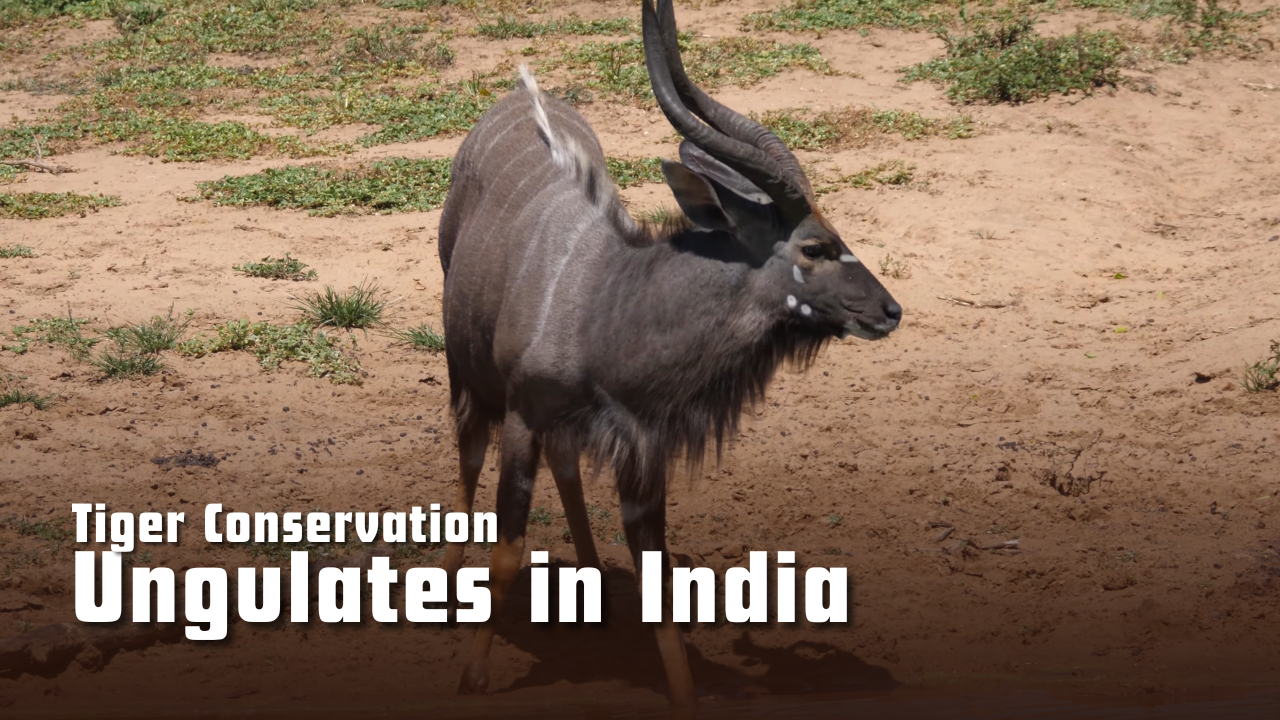Ungulates in India
State of India’s tiger prey, why challenges to their habitat need to be addressed
Context: For the first time, a detailed assessment of ungulates (hoofed mammals) in India has been made, covering species like deer, pigs, antelopes, and bison.
More on News
- Conducted by the National Tiger Conservation Authority and Wildlife Institute of India, using data from the 2022 All-India Tiger Estimation.
- The study is significant because ungulates form the core prey base for tigers and help regulate forest ecosystems and soil health.
Key Findings
- Spotted deer (chital), sambar, and gaur (Indian bison) populations are healthy in many parts but declining in Odisha, Jharkhand, and Chhattisgarh.
- Causes of decline:
- Severe habitat degradation
- Mining, infrastructure development
- Forest fragmentation
- Left-wing extremism areas
- Subsistence hunting
Healthy Zones
- Uttarakhand, the Western Ghats, central India, and the northeast still have healthy ungulate populations.
- Tiger reserves and national parks have better protection and higher prey densities.
- Sanctuaries and forest divisions adjacent to reserves have lower prey densities due to less protection.
Species-Wise Population Status
- Chital (Spotted Deer): Remains the most widespread and abundant ungulate in India. Its adaptability to a variety of habitats, including forest edges and agricultural interfaces, makes it a critical food source for tigers.
- Sambar: Populations are stable in most tiger landscapes, especially in the Western Ghats and central India.
- Wild Pig: Highly adaptable and found in good numbers across different terrains.
- Nilgai (Blue Bull): India’s largest antelope continues to thrive and often ventures into farmlands, contributing to human-wildlife conflicts.
- Gaur (Indian Bison): Found in healthy numbers in the Western Ghats, Eastern Ghats, and the Himalayan foothills. It prefers dense forests and hilly terrain.
- However, not all ungulates are faring well:
- Hog Deer: Their populations have seen a sharp decline due to the destruction of grasslands and wetland habitats. They now exist in isolated patches in the Terai grasslands and the floodplains of the Ganga and Brahmaputra.
- Barasingha (Swamp Deer): Once widespread, now confined to a few protected areas such as Kanha, Dudhwa, and Kaziranga. Despite reintroduction in Bandhavgarh and Satpura, it remains vulnerable due to its dependence on specific swamp-grassland habitats.
- Other Threatened Species: The wild buffalo, pygmy hog, and hog deer also face severe habitat-related challenges and genetic bottlenecks due to isolated populations and fragmentation.
Implications for Tiger Conservation
- India has 3,600+ tigers, accounting for 70% of the global tiger population.
- A declining prey base results in:
- Reduced tiger occupancy.
- Increased human-tiger conflict due to livestock predation.
- Tigers are forced to leave protected areas, seeking prey in human-dominated landscapes.
- Maharashtra and Madhya Pradesh are nearing their carrying capacity for tiger populations.
- Tigers are moving to east-central states (Odisha, Jharkhand, Chhattisgarh) with poor prey base.
- These regions have high potential but require urgent improvements in habitat and prey availability.
Major Conservation Challenges
- Habitat Loss and Degradation: Especially due to mining, infrastructure development, and conversion of wetlands and floodplains to agriculture or urban areas.
- Fragmentation of Habitats: Linear infrastructure such as highways, railways, and power lines interrupts wildlife corridors and alters animal behaviour and movement.
- Human Encroachment and Conflict: Subsistence hunting, livestock competition, and crop damage have led to increased tensions between humans and wildlife.
- Limited Genetic Exchange: Small, isolated populations of some species lack genetic diversity due to habitat fragmentation, increasing their vulnerability.
Conservation Recommendations
- Habitat Restoration: Reclaiming and reconnecting fragmented landscapes to allow free movement of ungulates and tigers alike.
- On-site Breeding and Enclosures: To bolster prey populations, especially in degraded or low-prey areas, controlled breeding in predator-proof enclosures could be employed.
- Enhanced Protection for Non-Reserve Forests: Forests outside tiger reserves must receive improved protection to support both prey and predator populations.
- Landscape-Level Planning: Conservation efforts should focus on ecological corridors and large-scale landscape connectivity rather than isolated pockets.
Conclusion
This assessment underscores the ecological interdependence between prey and predator. The health of ungulate populations is central not just to tiger survival, but also to the resilience of India’s forest ecosystems. The need of the hour is strategic conservation action, habitat restoration, and stronger protection to ensure that India’s wilderness remains robust for future generations.
Subscribe to our Youtube Channel for more Valuable Content – TheStudyias
Download the App to Subscribe to our Courses – Thestudyias
The Source’s Authority and Ownership of the Article is Claimed By THE STUDY IAS BY MANIKANT SINGH



